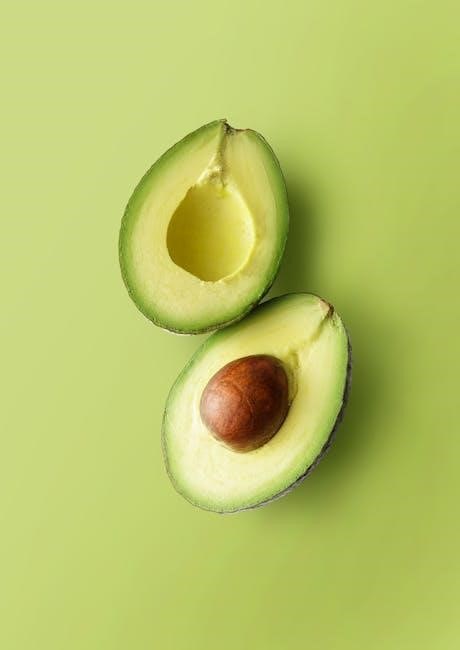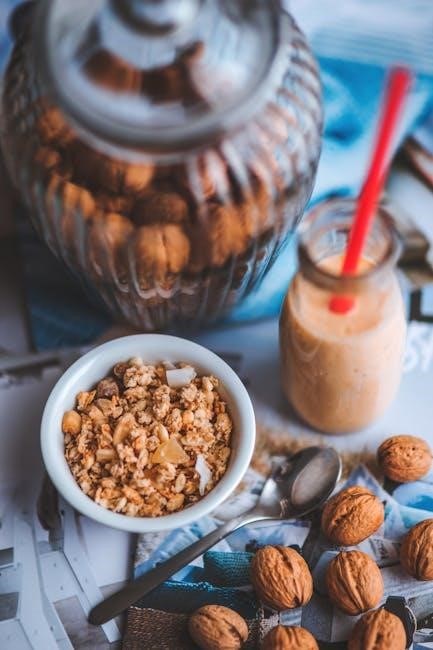Acid reflux occurs when stomach acid flows back into the esophagus, causing heartburn. GERD is the chronic form of this condition, requiring dietary and lifestyle adjustments to manage symptoms effectively.
1.1 Understanding Acid Reflux and Its Causes
Acid reflux occurs when the lower esophageal sphincter relaxes, allowing stomach acid to flow back into the esophagus. This causes heartburn and discomfort. Common triggers include fatty, spicy, or fried foods, obesity, and lying down after meals. Managing symptoms often involves dietary changes and lifestyle adjustments to reduce acid production and improve digestion.
1.2 What is GERD and Its Impact on Health
GERD, or gastroesophageal reflux disease, is a chronic condition where acid reflux occurs frequently, causing persistent heartburn and discomfort. If left unmanaged, GERD can lead to complications like esophagitis, narrowing of the esophagus, or Barrett’s esophagus, increasing the risk of serious health issues. Managing GERD through diet and lifestyle changes is essential to prevent long-term damage and improve quality of life.
The Role of Diet in Managing Acid Reflux
Diet plays a crucial role in managing acid reflux by avoiding trigger foods and focusing on low-acid, balanced meals to reduce symptoms and improve digestion.
2.1 How Diet Affects Acid Reflux Symptoms
Diet significantly impacts acid reflux symptoms by influencing stomach acid production and esophageal irritation. Certain foods like citrus, spicy, or fatty items can trigger reflux, while others, such as lean proteins and non-citrus fruits, may alleviate symptoms. Understanding how specific foods affect digestion and sphincter function is key to managing discomfort and preventing flare-ups effectively.
2.2 The Importance of a Low-Acid Diet
A low-acid diet is crucial for managing acid reflux as it reduces esophageal irritation and prevents excessive acid production. Avoiding high-acid foods like tomatoes and citrus helps minimize symptoms, while incorporating alkaline options supports a balanced digestive environment. This approach is often the first line of treatment, offering relief and improving quality of life for those with GERD.
Foods to Avoid for Acid Reflux
Fried, spicy, and fatty foods are common triggers. They can relax the lower esophageal sphincter and slow digestion, leading to acid reflux. Avoiding them can reduce symptoms effectively.
3.1 Common Trigger Foods and Their Effects
Common trigger foods like citrus fruits, tomatoes, chocolate, and caffeine can weaken the lower esophageal sphincter, allowing stomach acid to flow back into the esophagus. Fried, spicy, and fatty foods delay digestion, increasing pressure on the sphincter. Alcohol and carbonated beverages can also relax the sphincter, exacerbating symptoms. Identifying and avoiding these triggers can significantly reduce acid reflux episodes and improve overall comfort.
3.2 Why Fried, Spicy, and Fatty Foods Should Be Limited
Fried, spicy, and fatty foods can trigger acid reflux by relaxing the lower esophageal sphincter, delaying stomach emptying, and increasing pressure on the sphincter. These foods can cause symptoms like heartburn and discomfort. Limiting them helps reduce reflux episodes and supports a healthier digestive system, making it easier to manage GERD symptoms effectively.
Recommended Foods for Acid Reflux
Non-citrus fruits, lean meats, and healthy fats are ideal for managing acid reflux. These foods help reduce symptoms and promote a balanced digestive system, easing discomfort.
4.1 Non-Citrus Fruits and Their Benefits
Non-citrus fruits like bananas, melons, and apples are ideal for acid reflux. They are low in acid and high in fiber, promoting digestion. These fruits soothe the esophagus and reduce inflammation, making them a great choice for meals or snacks to alleviate symptoms naturally and support overall digestive health.
4.2 Lean Meats and Healthy Fats for a Balanced Diet
Lean meats like chicken, turkey, and fish are excellent choices for managing acid reflux. They are low in fat and easy to digest. Healthy fats, such as those from avocados, olive oil, and nuts, also support digestion without triggering symptoms. These foods help maintain a balanced diet, reducing inflammation and promoting overall gastrointestinal health while keeping acid reflux under control.

Meal Planning Strategies
Plan meals to include smaller, frequent portions to reduce stomach pressure. Avoid eating close to bedtime and opt for low-acid, balanced meals to manage symptoms effectively.
5.1 Eating Smaller, More Frequent Meals
Eating smaller, more frequent meals reduces stomach pressure, minimizing acid reflux. This approach prevents overloading the stomach, which can trigger symptoms. Opt for balanced, low-acid options and avoid heavy meals close to bedtime. Incorporating lean proteins, non-citrus fruits, and vegetables helps manage symptoms effectively. This strategy also aids in maintaining a healthy weight, further reducing GERD risks.
5.2 Avoiding Late-Night Eating and Bending Over
Avoiding late-night eating and bending over after meals can significantly reduce acid reflux symptoms. Lying down immediately after eating disrupts the lower esophageal sphincter, allowing stomach acid to flow back into the esophagus. Waiting at least 2-3 hours after meals before reclining or sleeping helps prevent nighttime heartburn. Additionally, bending over can increase abdominal pressure, worsening reflux, making it essential to avoid such activities post-meal.

Lifestyle Changes to Alleviate Symptoms
Lifestyle changes play a crucial role in managing acid reflux. Maintaining a healthy weight reduces stomach pressure, while avoiding alcohol and caffeine helps minimize esophageal irritation and reflux episodes.
6.1 Weight Management and Its Role in Reducing Symptoms
Maintaining a healthy weight is crucial for managing acid reflux. Excess weight increases stomach pressure, pushing acid into the esophagus. Losing even a small amount of weight can significantly reduce symptoms. A healthy BMI helps prevent chronic conditions like GERD and improves overall well-being, making weight management a key component of an effective acid reflux diet plan.
6.2 The Benefits of Avoiding Alcohol and Caffeine
Avoiding alcohol and caffeine can significantly reduce acid reflux symptoms. Both substances relax the lower esophageal sphincter, allowing stomach acid to flow back into the esophagus. Eliminating these triggers helps prevent heartburn and supports healing. Cutting out alcohol and caffeine is a key recommendation in GERD diet plans, promoting better digestive health and symptom relief for those managing acid reflux.

Supplements and Natural Remedies
Supplements like antacids and natural remedies such as ginger and aloe vera can help neutralize stomach acid and soothe the esophagus, providing relief from acid reflux symptoms.
7.1 Over-the-Counter Medications for Acid Reflux
Over-the-counter medications such as antacids, histamine-2 (H2) blockers, and proton pump inhibitors (PPIs) can effectively alleviate acid reflux symptoms by neutralizing stomach acid or reducing its production.
7.2 Natural Remedies Like Ginger and Aloe Vera
Natural remedies such as ginger, known for its anti-inflammatory properties, and aloe vera, which soothes the esophagus, can provide relief from acid reflux symptoms. These natural options are often incorporated into diet plans to complement lifestyle changes and medications.

Creating a Personalized Diet Plan
Creating a personalized diet plan involves tailoring meals to individual needs, tracking triggers, and consulting experts for a customized approach. Downloadable PDF resources can guide this process effectively.
8;1 Keeping a Food Diary to Track Triggers
Keeping a food diary helps identify specific foods that trigger acid reflux symptoms. By recording meals, portion sizes, and symptom occurrences, individuals can pinpoint problematic foods. This tool aids in creating a personalized diet plan and understanding how different foods affect digestion. Regularly reviewing the diary with a healthcare provider ensures tailored advice for managing GERD effectively.
8.2 Consulting a Healthcare Provider for Customized Advice
Consulting a healthcare provider is essential for personalized advice on managing acid reflux. They can review your food diary, medical history, and symptoms to create a tailored diet plan. A healthcare professional can also recommend supplements or medications if needed, ensuring a comprehensive approach to reducing GERD symptoms and improving overall digestive health effectively;

Sample 7-Day GERD Diet Plan
A structured 7-day GERD diet plan offers low-acid meal ideas for breakfast, lunch, dinner, and snacks, helping to alleviate symptoms and promote digestive health.
9.1 Breakfast, Lunch, Dinner, and Snack Ideas
Start with oatmeal or non-citrus fruits for breakfast. Lunch options include lean meats, vegetables, and whole grains. Dinner ideas feature baked fish or poultry with low-acid sides. Snacks like fresh veggies or low-fat yogurt help manage symptoms throughout the day. These meals focus on avoiding triggers and promoting digestion.
9.2 Low-Acid Meal Recipes for Each Day
Day 1: Oatmeal with almond butter, grilled chicken salad, baked cod with steamed veggies, and cucumber slices. Day 2: Scrambled eggs with spinach, quinoa bowl with turkey, roasted sweet potatoes, and apple slices. Day 3: Smoothie with spinach, banana, and almond milk, lean beef stir-fry, mashed cauliflower, and melon. Each recipe avoids acidic ingredients, promoting digestion and symptom relief.
Monitoring Progress and Adjustments
Track symptoms daily using a food diary to identify triggers. Adjust the diet plan based on symptom improvement and consult a healthcare provider if needed for further guidance.
10.1 How to Track Symptom Improvement
Use a food diary to log daily meals and symptoms. Note the severity of heartburn, bloating, and discomfort. Regularly review entries to identify patterns and triggers. Adjust the diet plan based on observations, ensuring gradual symptom reduction. This systematic approach helps refine the GERD diet plan for better long-term management and relief from acid reflux symptoms effectively.
10.2 When to Seek Further Medical Help
If symptoms persist despite dietary changes, consult a healthcare provider. Seek medical help if experiencing severe chest pain, difficulty swallowing, or vomiting blood. Persistent heartburn unresponsive to OTC medications or worsening symptoms may indicate complications. A doctor can recommend advanced treatments or further testing to ensure proper management of GERD and prevent long-term esophageal damage.

Common Mistakes to Avoid
Common mistakes include overeating, continuous snacking, and ignoring trigger foods, which can worsen symptoms and hinder progress in managing acid reflux effectively.
11.1 Overlooking Hidden Triggers in Foods
Many individuals overlook hidden triggers like preservatives, additives, or certain spices in processed foods that can silently provoke acid reflux symptoms. These elements can relax the lower esophageal sphincter or delay stomach emptying, leading to discomfort. Identifying and avoiding such hidden culprits through a food diary or consultation with a healthcare provider is crucial for effective symptom management and long-term relief.
11.2 The Risks of Overeating or Continuous Snacking
Overeating or continuous snacking can exacerbate acid reflux by overwhelming the stomach, delaying digestion, and increasing pressure on the lower esophageal sphincter. This leads to acid backflow and discomfort. Adhering to portion control and allowing adequate time between meals helps prevent these issues and supports overall digestive health, making it easier to manage GERD symptoms effectively.
A well-structured GERD diet plan significantly reduces symptoms, improving overall well-being. Printable resources like GERD diet PDFs offer practical meal guides, while consulting healthcare providers ensures personalized advice for long-term relief.
12.1 The Long-Term Benefits of a GERD Diet
A GERD diet offers long-term benefits by reducing chronic inflammation, preventing esophageal damage, and minimizing reliance on medications. Consistent adherence can improve digestion, enhance overall health, and significantly lower the risk of complications associated with untreated acid reflux, leading to a better quality of life and fewer medical interventions over time.
12.2 Where to Find Printable GERD Diet PDFs
Printable GERD diet PDFs are widely available online, offering structured meal plans and guidelines. Reputable sources include health organizations like the American College of Gastroenterology and the National Institute of Diabetes and Digestive and Kidney Diseases. These resources provide comprehensive guides, sample meal plans, and expert recommendations to help manage acid reflux effectively. They are designed to be user-friendly and adaptable to individual needs.

No Responses